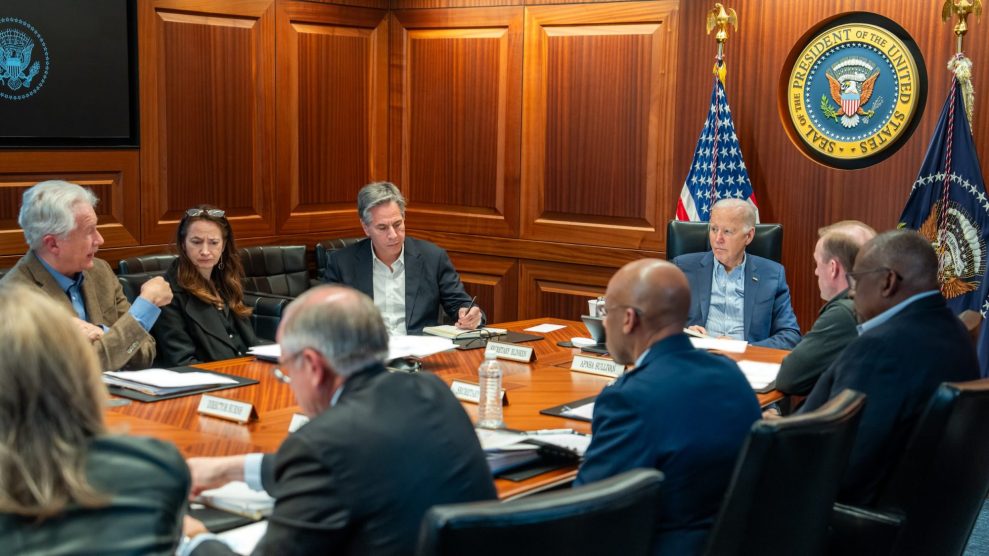When the esteemed ethicist the Rev. Dr. J. Philip Wogaman left his long-held teaching post at Wesley Theological Seminary in 1992 to return to the pulpit, he landed a plum assignment as pastor of Foundry United Methodist Church in Washington, D.C., the church of presidents since John Quincy Adams.
But when the current first family began attending services at Foundry, Wogaman found himself under criticism far more malicious than any he had encountered in academia–where he used to joust over issues such as whether to accept lesbians and gays in the church. The target of a campaign to discredit the president’s pastor, he became the subject of newspaper articles and columns designed to portray him as a dangerously left-wing cleric.
What happened to Wogaman was not inadvertent: Despite the serious difficulties faced by America’s mainstream religious community since its heyday in the 1960s, neoconservatives and the Christian right still consider it a powerful threat. Over the last decade, right-wing foundations have spent millions to divide mainline congregations and attack individual clerics and church organizations.
The assault on Clinton’s pastor was the brainchild of a neoconservative group known as the Institute on Religion & Democracy (IRD). Based in Washington, D.C., IRD was launched in 1981 by Father Richard John Neuhaus, a former Lutheran pastor turned Catholic priest who now edits the journal First Things, and Michael Novak, a Catholic writer and fellow at the American Enterprise Institute.
IRD’s initial plan was to take on the Roman Catholic liberation theologians causing trouble for dictators and corporate interests in Latin America. Soon, however, IRD shifted its sights, focusing on progressive forces in mainline Protestant churches. In 1992 alone, the group spent $702,000 on monitoring mainstream churches.
In Wogaman’s case, the assault came in the spring 1995 issue of the IRD journal, Faith and Freedom. IRD researcher Mark Tooley, a former CIA agent, pored through 30 years of Wogaman’s writings, pulled out the most controversial bits–especially anything that appeared to show socialist sympathies–and wrote an “exposé.” Right-wing pundit Cal Thomas then used snippets for his syndicated column in the Washington Times. Shortly after his piece ran, Senate Majority Leader Bob Dole, who had worshiped at Foundry for years with his wife, Elizabeth, broke his Sunday habit and began attending a different church.
Wogaman finds his sudden infamy difficult. “I’m having to learn how to think and speak in sound bites, and it’s not easy for me,” he says. “I’m used to having an audience who at least will hear me out.”
Much of IRD’s agenda centers on creating media campaigns to rouse dissension within mainline churches. The campaigns are especially effective when they exploit internal debates over sexual morality, homosexuality, and feminist theology.
In 1993, for example, the national Presbyterian Church co-sponsored an ecumenical conference for women at which participants discussed biblical references to a little-understood concept theologians call Sophia, thought to represent the feminine component of divine wisdom. IRD sent a source and later landed a story alleging church-sponsored paganism on ABC’s “Nightline.” A top church official lost her job, and 300 churches refused to fork over their annual dues to the national church office, leaving the denomination some $1 million in the hole.
That attack was similar to a 1983 IRD campaign against the National Council of Churches and its sister organization, the World Council of Churches, for their opposition to apartheid in South Africa. When “60 Minutes” ran a piece built on IRD allegations that humanitarian aid from the church councils was being used by Marxist regimes to buy guns, IRD scored big — even though the allegations were never proved and the church councils say they were completely false. Parishioners from member churches demanded their denominations withdraw from the NCC, and the respected organization lost credibility.
Today, IRD operates discrete programs targeting Presbyterians, Episcopalians, and Methodists — and has just added a new program, the Ecumenical Coalition on Women and Society, “a committee of churchwomen who combat radical feminism in our churches,” says IRD President Diane Knippers.
The programs include quarterly briefings about “heresies” committed by church leaders in particular denominations. In 1992, armed with money from the Olin, Bradley, and Smith Richardson foundations, IRD spent more than $31,000 on the Episcopal program, nearly $43,000 against the Methodists, and $64,000 persecuting the Presbyterians.
These battles keep religious progressives on the defensive. “If you’ve got people on the run within their denominations,” says Mary E. Hunt, co-director of the Women’s Alliance for Theology, Ethics, and Ritual in Silver Spring, Md., “you don’t have them available to a larger framework.”
That, pretty clearly, is the goal of a book mailed to new IRD members: Prophets & Politics: A Handbook on the Washington Offices of U.S. Mainline Churches by Roy Howard Beck. The handbook focuses on the influence of 15 mainline Christian denominations on Congress. Chock-full of charts and graphs, it details denominational funding and positions on various issues.
As Beck points out, when the 15 denominations are divided on an issue, “expect painful polarization in Congress, as well as in the public.” But, he adds, “when most of the 15 speak in unison…it is almost impossible for an opponent to beat them.”
Back to Keeping Faith.















